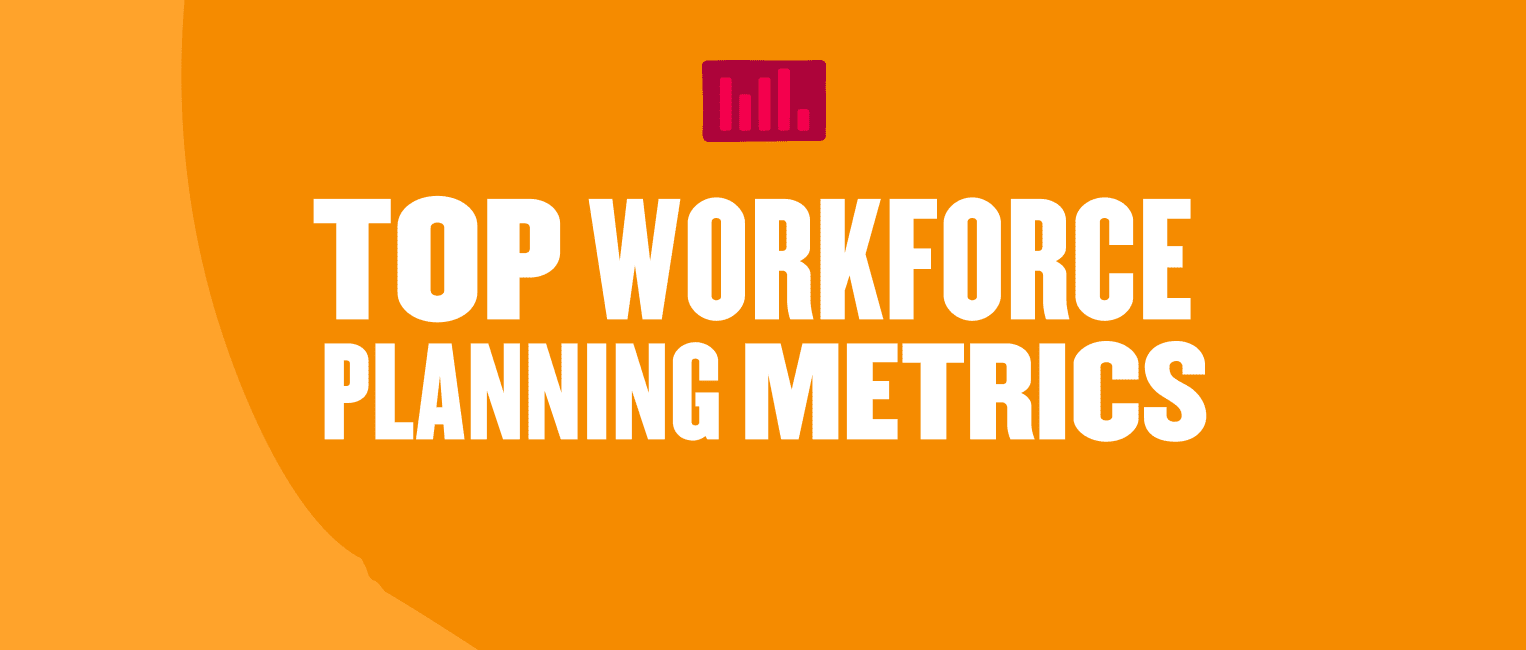Workforce planning is the cornerstone of any good recruitment plan and enables modern HR professionals to analyze, forecast, and plan workforce supply and demand. One of the best ways to understand how to translate organizational needs into new hires and guarantee a strong team with high-quality professionals and low attrition rates is to leverage workforce planning metrics.
What are workforce planning metrics?
Workforce planning metrics gather information about a workforce from people in the business, people processes, and the wider labor market. HR professionals can use workforce metrics to track and analyze performance and leverage their findings to make data-driven decisions.
To help you understand how successful your plans are and what you should be working on improving for the future, we’ve put together a list of 22 metrics that can provide insight and guidance into your workforce planning process’ effectiveness.
- Age, race, and gender diversity ratio
- Headcount
- Full-time employees
- Internal mobility rate
- Contract type and distribution
- Age
- Tenure distribution
- Career path ratio
- Employee engagement scores
- Retention rate
- Voluntary vs. involuntary turnover
- Attrition
- Bench strength
- Competencies
- People profiles and assessments
- Quality of hire
- Annual failed hires
- Reasons for resignation
- Absenteeism
- Time to hire
- Training ratio
- eNPS
Strategic workforce planning metrics
1. Age, race, and gender diversity ratios
Is your organization as diverse as it could be? The most successful workforce planning processes have an inclusive hiring plan.
When building an inclusive hiring plan, be sure to actively seek out applicants who will strengthen your company culture and bring a diversity of experience, opinion, age, gender, race, ethnicity, and any other qualities that will add to your organization’s diverse and inclusive character.
2. Headcount
Headcount is the easiest metric to measure: How many people are currently employed by your organization?
You can break this down by departments and teams, but the principle stays the same: Count ’em up and you’ve got headcount.
Measuring your headcount shows you what you already have, and it can serve as the foundation of your workforce management plan.
3. Full-time employees
A deeper dive into your newfound headcount metric will reveal how many people are on full-time contracts. Knowing this core number helps you better plan for change and any emerging trends in your workforce needs.
4. Internal mobility rate
Understanding the number of people who move laterally between teams adds another layer to the bigger organizational picture. It also provides insight into how many and which open roles are being filled by the talent within the organization. If you have a high internal mobility rate, it’s a sign that you have a strong succession plan.
5. Contract type and distribution
Once you know the type of employment contracts your people are on, whether full-time, part-time, or freelance, you can leverage your diverse workforce to help scale the organization. And by taking the core number of full-time employees as your foundation combined with the needs of the business, you can better understand how many people you may need to hire part-time or as freelance contractors.
6. Age
As well as adding value, employing a multi-generational workforce can present HR professionals with challenges. That’s because different people will bring their own generation’s particular expectations and experiences to the workplace. Diverse, multi-generational workforces can have the advantage of different generations’ strengths and modes of thinking. When your people work together to find mutual understanding and common ground, their various strengths can come together to propel ingenuity and drive the business forward.
7. Tenure distribution
How long is the average tenure of your workforce? Can you improve it? Use the tenure distribution metric to understand who your high-potential talent is. If you notice that much of your senior leadership has been hired externally, take the opportunity to identify who to invest in with upskilling and professional development opportunities, and save on recruitment costs by promoting from within.
8. Career path ratio
This HR metric helps calculate individual’s rates of vertical and lateral growth within your organization. It helps companies analyze the structure of their organization and how individuals with particular skill sets are placed within it.
9. Employee engagement scores
When the employee engagement score is low, it’s common to see low employee morale and productivity and high rates of attrition. Use this metric to gain more insight into where and how to invest in enhancing people programs across your organization.
10. Retention rate
Keeping retention high is always a top priority. When planning hires for the next year or cycle, understanding your retention history can help you determine which departments require more headcount and how best to allocate the recruitment team’s resources.
11. Voluntary vs. involuntary turnover
When calculating turnover, it’s important to understand the rates of voluntary and involuntary turnover. In other words, who wants to leave and who are you letting go?
If your involuntary turnover is high, consider examining the quality of your hires. If your voluntary turnover is high, you may need to evaluate your company culture and think about what and how you can improve.
12. Attrition
Measuring attrition is critical for workforce planning because it tells you how fast people are voluntarily leaving your company.
To plan for future hiring efforts, you need to understand the resources your organization can commit to its people. A high attrition rate may show that your organization isn’t in the right place to be hiring.
13. Bench strength
Every organization has departures, voluntary and involuntary. To ensure business operations aren’t interrupted when people leave, it’s best practice to have internal talent ready to fill in and take on the responsibility—temporarily or long-term.
Measuring your bench strength can help identify high-potential individuals on your teams. From there, you can more easily determine internal candidates for promotions or lateral moves across your organization.
14. Competencies
How skilled are your people? Do they have the knowledge and experience your business needs to succeed? Understanding where people’s competencies lie within the business helps indicate how well-equipped your organization is to face any challenges, adapt, and thrive. It can also help pinpoint where to invest in specific professional development and training programs for your people.
15. People profiles and assessments
Many modern businesses already employ their future leaders and the top talent who will help the company realize its full potential. Success lies in identifying those people and matching them with the capabilities and profiles needed to future-proof your organization.
HR professionals can collate scores and create in-depth people profiles from questionnaires, surveys, and personality tests to build a point of reference when looking to promote internally.
16. Quality of hire
Understanding your quality of hire can help you learn from past mistakes and build on past successes. When your quality of hire is high, it helps boost retention, employee satisfaction, and overall productivity.
17. Annual failed hires
Knowing how many new hires haven’t reached their first anniversary with an organization can highlight areas for improvement. Exit interviews can help shine a light on what might be happening and give you insight into how to engage and retain new talent.
18. Reasons for resignation
Taking note of people’s reasons for leaving at their exit interview is an invaluable way to inform future decision-making around recruitment—and prevent high levels of voluntary turnover.
19. Absenteeism
Leverage absenteeism metrics to understand how many people are taking unplanned leave or frequent single days off at any given time. When these rates are high, it can indicate high levels of burnout and low employee engagement.
20. Time-to-hire
Workforce planning allows you to get ahead of any urgent needs. Understanding your historic time-to-hire can help you understand where you can make improvements in your recruitment process. For example, reducing the number of interviews and overall length of the interview process may help you avoid losing out on top candidates who accept competing offers.
As your recruiting process grows more efficient (and, hopefully, your eNPS improves), your time-to-hire will shrink and your teams will grow stronger and faster than ever.
21. Training ratio
Now that you have your new hire set up, who can train them?
Training ratio measures the number of fully trained team members versus those who need more training. If you see that you have a low training ratio, consider incorporating advanced training sessions, continuing education courses, and maybe even tuition reimbursements into your budget.
22. eNPS
eNPS is the holy grail of employee engagement. Your eNPS score will help you understand if your people are happy—and if they’ll make recruiting easy by lending a hand.
Happy employees tend to stick around—so a high eNPS score can lead to a smoother, more predictable workforce planning process.
Best practices: Workforce planning KPIs
When defining your KPIs, it’s important to establish metrics that will indicate whether or not your plan is on track to succeed. More and more successful modern businesses rely on real-time metrics for insights into what’s working, what’s not, and how they might improve outcomes.
Examples of HR KPIs to include in your workforce planning program include:
- Employee engagement rate
- Training ROI
- Quality of hire
- Absenteeism rate
- Turnover rate
- Retention rate
- Disciplinary rate
- Grievance rate
HR professionals who identify between five and seven workforce planning KPIs are better able to effectively manage and track their progress in meeting their goals.
Recommended For Further Reading
Measuring with a workforce planning dashboard
Traditionally, HR professionals use spreadsheets, paper records, or external systems for workforce planning. Using a workforce planning tool with an intuitive dashboard can help automate the process, collect data, and provide accurate, data-driven insights HR leaders can use to accurately measure workforce efficiency and planning metrics.
How Bob helps track and analyze strategic workforce planning metrics
Bob’s Workforce Planning was designed to help businesses build data-driven, strategic hiring strategies. It gives you complete visibility into all your people data, including headcount, expected turnover and growth, and the ability to track current and future positions—in one place.


